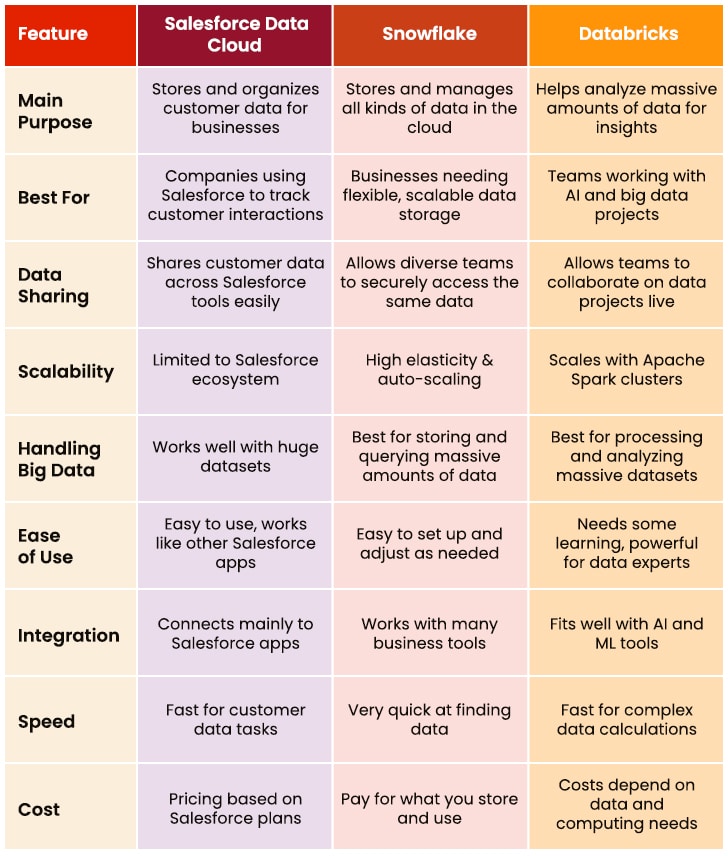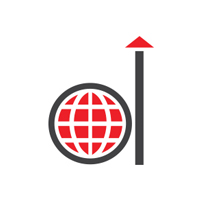Imagine running a business where you know exactly what your customers want before they ask. Where every decision is fast and backed by data. That’s the power of data platforms, they turn raw information into clear, accurate insights.
Today, three big names lead the pack: Salesforce Data Cloud, Snowflake, and Databricks. But how do you opt for the right data platform? Each platform has its own strengths. In this detailed post, we’ll break down these three platforms. This helps you understand which one fits your business needs best. Ready to find the perfect match? Let’s go!

Table of Contents
A Quick Rundown on Salesforce Data Cloud (SDC)
A Quick Overview of Databricks
Salesforce Data Cloud vs. Snowflake vs. Databricks: Key Comparison of Core Features
Salesforce Data Cloud vs. Snowflake vs. Databricks: Strengths and Weaknesses
Salesforce Data Cloud vs. Snowflake vs. Databricks: Which Data Platform You Should Use
Popular Use Cases of Salesforce Data Cloud
A Quick Rundown on Salesforce Data Cloud (SDC)
SDC helps businesses keep all their customer data in one place. When companies work with customers, they get data from multiple channels. This tool organizes information from different sources, making it easier to see and understand.
It lets businesses remember what customers buy, how they shop, or what they might buy next. This helps companies understand their customers better. For instance, if someone buys shoes often, the store can show them new arrivals. If they ask questions, the support team can see their history to help faster. This way, businesses can send the right offers, answer questions faster, and make shopping experiences more personal. The best part? It updates automatically, so the information is always fresh.
The tool works with other Salesforce products. Sales, marketing, and service teams can all use the same customer details without checking different systems. This saves time and helps give customers what they want.
Basically, it organizes customer information so businesses can help customers better.
Key Features of SDC
- Unified Data: SDC combines data from apps, websites, and other systems into a single view. No more scattered data; everything is in one place.
- Smart Insights: SDC finds patterns in data to help businesses understand customer needs. It suggests actions to improve sales and service.
- Real-Time Updates: It keeps data fresh, so businesses always have the latest information. No waiting, changes show up instantly.
- Easy Personalization: It helps create tailored marketing and recommendations. Customers get offers and messages that fit their interests.
- Works with Salesforce Tools: SDC connects smoothly with other Salesforce solutions. No extra effort needed; everything just flows together.
SDC, a Game-Changer for Fragmented Customer Data Management:
A Quick Overview of Snowflake
Snowflake is a data platform that allows businesses to store, analyze, and share data. It keeps information safe in the cloud, letting companies access it from anywhere. Unlike traditional systems, it can grow bigger or smaller as needed. Teams can share data easily without copying files. It works with many other tools people already use. Snowflake can handle numbers, reports, and customer information efficiently. This helps businesses make better decisions without worrying about storage limits or technical roadblocks.
Key Features of Snowflake
- Cloud Storage: Snowflake keeps all your data safe in online storage. You can access it from anywhere without needing physical servers. It automatically takes care of space, so you never run out of room for your files.
- Automatic Scaling: The system adjusts resources by itself. When you need more power, it adds it. When you need less, it reduces. You are required to only pay for what you actually use.
- Works with Everything: Snowflake connects to tools you already use. Whether it’s business apps or analysis programs, your data flows smoothly between them without extra work.
- Always Running: The service stays up nearly all the time. You can access your data whenever needed without unexpected downtime.
A Quick Overview of Databricks
Databricks is a tool that helps businesses work with huge datasets. It lets teams store, clean up, and study data all in one place. The tool spots hidden patterns and connections in data that might be hard to see otherwise. It is useful for solving problems and helping companies make smart choices.
Key Features of Databricks
- All-in-One Data Workspace: Everything needed to work with data stays in one spot. You can store information, write code, and see results without switching between different tools. Teams can see and use the same updated information.
- Teamwork Friendly: Many people can work together on the same data projects. Changes appear for everyone right away. You can leave notes and share findings with teammates easily.
- Handles Big Jobs:It works well with huge amounts of information that would slow down regular computers. The system automatically adjusts to handle bigger or smaller tasks as needed.
- Works Everywhere: Since it’s cloud-based, you can access your work from any computer. All your projects and data stay safe and available whenever you need them.
- Connects to Other Tools: It works with many common business tools. You can bring in data from different places without starting over or losing information.
- Fast Answers: Even with lots of information, it gives quick results. You don’t have to wait long to see patterns or get answers to your questions.
Salesforce Data Cloud vs. Snowflake vs. Databricks: Key Comparison of Core Features
These three platforms help businesses manage data differently. Salesforce Data Cloud works best with customer data. Snowflake stores and organizes large-scale data. Databricks helps analyze complex data for tech teams. Below, we compare their main features to help you pick what fits your needs.

Salesforce Data Cloud vs. Snowflake vs. Databricks: Strengths and Weaknesses
Choosing between these data platforms depends on what your business requires. Some work better for sales teams, others for storing lots of data, and some for analyzing information. Each has areas where it performs well and areas where it might not be the best fit. The pointers below highlight the pros and cons of each tool.
Data Cloud Salesforce
Pros of Data Cloud Salesforce
- Easy for Salesforce users: If your company already uses Salesforce, this fits right in. You don’t need to invest time learning a novel system. Everything connects smoothly.
- Great for customer data: It’s built to track customer info like purchases, emails, and support tickets. No extra setup needed.
- Ready-to-use reports: It comes with dashboards that show customer trends without needing coding skills.
- Simple sharing: Sales, marketing, and support teams can all see the same customer details in real-time.
- Good automation: It can trigger actions (like sending emails) based on customer behavior automatically.
Cons of Data Cloud Salesforce
- Only for customer data: It is not good for storing other types of data like financial records or product details.
- Works best with Salesforce: It is hard to connect with non-Salesforce tools compared to others.
- Expensive: It costs more than general-purpose tools, especially for big companies.
- Less flexible: It can’t customize as much as other platforms for special needs.
Snowflake
Pros of Snowflake
- Handles any data type: Snowflake is good for handling customer data, numbers, documents, and more in one place.
- Grows with you: It automatically adds more space when needed, without slowing down.
- Easy sharing: It lets teams use the same data without making messy copies.
- Works with many tools: It connects to most business apps without extra hassle.
- No maintenance: Snowflake runs itself, so you don’t need IT staff to manage servers.
Cons of Snowflake
- Not for deep analysis: Snowflake is great for storage but needs other tools (like Databricks) for complex data science.
- Can get pricey: It costs add up if you store a lot of data or run many queries.
- Less user-friendly: It requires some technical skills to set up compared to Salesforce.
- No built-in AI: It doesn’t have smart features like Databricks for finding patterns.
- Slower for huge tasks: It takes longer than Databricks for heavy data processing.
Databricks
Pros of Databricks
- Best for big data: Databricks handles massive datasets faster than most tools.
- Great for AI/advanced work: It is built for data scientists doing machine learning or predictions.
- Cleans messy data: It fixes errors and finds patterns automatically.
- Team collaboration: It allows many people to work on the same data projects live.
- Works with AI tools: It connects easily to popular AI and coding platforms.
Cons of Databricks
- Hard for beginners: Databricks needs coding knowledge to use well (not for casual users).
- Expensive for small teams: It costs more than simpler tools unless you need its power.
- Too much for basic needs: Overkill if you just need storage or simple reports.
- Steep learning curve: It takes time to learn all its features.
- Not for customer tracking: It is less focused on sales/marketing data than Salesforce.
Salesforce Data Cloud vs. Snowflake vs. Databricks: Which Data Platform You Should Use
Not all data platforms work the same way. Before choosing, think about whether you need sales tools, data storage, or analysis features. The table makes it easy to compare them side by side for your specific requirements.
| Choose Salesforce Data Cloud Architecture if: | Choose Snowflake if: | Choose Databricks if: |
|---|---|---|
| You already use Salesforce and want to manage customer data better | You need a place to store large amounts of any type of data | You work with really big datasets and need fast analysis |
| Your main goal is tracking customer interactions, sales, and marketing | You want a system that grows or shrinks based on your needs | Your team does advanced data science or AI projects |
| You need data to connect easily with other Salesforce tools | Different teams need to access the same data without making copies | You need to clean unstructured data and discover hidden insights |
| You want ready-made reports and dashboards for customer insights | You work with many different business tools and apps | Multiple people need to work together on data projects in real-time |
| Your team prefers simple, no-code tools for handling data | You prefer a simple setup without managing servers | You’re comfortable with coding (or have data experts on your team) |
Popular Use Cases of Salesforce Data Cloud
Businesses of all sizes use Salesforce Data Cloud for important functions. It helps teams work better with customer information. Below are the ways businesses are putting Salesforce Data Cloud to work in their daily operations.
1. Better Customer Profiles
It helps businesses combine all customer data in one place. This gives a complete view of each customer, making it easier to understand their needs better.
2. Personalized Marketing
By using customer data, companies can send tailored offers. For example, if someone buys a new smartphone, they might get suggestions for a screen protector.
3. Faster Customer Service
With all customer info in one spot, support teams can quickly see past interactions and solve problems faster. No more asking customers to repeat their issues!
4. Tracking Sales Trends
Businesses can analyze sales data to see what’s selling fast. This helps them stock the right products and plan better deals.
5. Automating Routine Tasks
Data Cloud can automate tasks like sending thank-you emails or updating customer records. This saves time and reduces human errors.
Elevating Customer Data Management with Salesforce Partner Edge:
Proven Use Cases of Snowflake
Businesses use Snowflake in multiple useful ways. It supports teams that need to work with lots of information. The following are the most common ways companies put Snowflake to work in their operations.
1. Storing Huge Data
Snowflake lets businesses store tons of data in one secure place. It’s like a giant digital warehouse where everything stays organized and easy to find.
2. Quick Data Analysis
Companies can run fast searches on their data to find trends, like which products sell best or which ads work. Snowflake makes this easy without slowing down the system.
3. Sharing Data Safely
Teams or even different companies can safely share data in Snowflake without risking leaks. For example, a store can share sales numbers with its supplier without exposing customer details.
4. Powering Apps & Reports
Snowflake provides clean, updated data for apps and dashboards. So, when you see real-time stats (like weather apps or stock prices), Snowflake might be working in the background.
5. Saving Money on Storage
Unlike old systems, Snowflake lets businesses pay only for the storage and computing power they use. This cuts costs because you don’t pay for unused space.
Promising Use Cases of Databricks
Businesses use Databricks in smart ways. It helps teams that need to dig deep into data. The following are the most popular ways companies use Databricks in their operations.
1. Analyzing Big Data Quickly
It helps companies process huge amounts of data fast. For example, a store can check millions of sales records to find out which products are popular. This helps them make better decisions.
2. Building Smart AI Models
Businesses use it to train AI for tasks like predicting sales or spotting fake transactions. Databricks makes it easy to test and improve these models before using them.
3. Cleaning Messy Data
Data often comes in messy formats. Databricks can organize and clean it, like fixing missing info or removing duplicates, so that companies can trust their reports and insights.
4. Team Collaboration on Data Projects
It lets teams work together on the same data projects. Everyone can access, edit, and share data securely in one place.
Summing Up
Choosing between Salesforce Data Cloud, Snowflake, and Databricks is like picking the right tool for a job. Each one shines in its way. Your choice depends on what your business needs most. Want to improve marketing? Salesforce might be best. Need a secure data warehouse? Snowflake could win. Building smart AI tools? Databricks may be the answer. Think about what matters most to your business, and you’ll find the perfect match. In case you want to customize the Salesforce data platform, you may seek Salesforce data cloud services from a certified partner.





